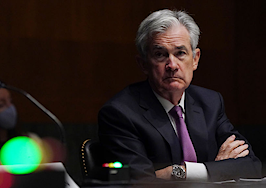Rising mortgage rates put a damper on purchase loan applications last week, but interest rates have since reversed course on the rising tensions and economic uncertainty created by Russia’s invasion of Ukraine.
During the week ending Feb. 25, requests for purchase loans were down by a seasonally adjusted 2 percent compared to the week before, and down 9 percent from a year ago, according to the Mortgage Bankers Association’s Weekly Mortgage Applications Survey. Requests to refinance were up 1 percent week over week, but were down 56 percent from a year ago.

Joel Kan
“Mortgage rates last week reached multi-year highs, putting a damper on applications activity,” MBA forecaster Joel Kan said, in a statement. “The 30-year fixed rate reached its highest level since 2019 at 4.15 percent, and the refinance share of applications dipped below 50 percent.”
Mortgage rates had been on the rise this year as bond investors who fund most home loans worried about the prospect of further tightening by the Federal Reserve as inflation continues to defy expectations.
Having wound down a $120 billion-a-month quantitative easing program that brought interest rates to all-time lows during the pandemic, Fed policymakers have signaled that they’re now eager to begin raising short-term interest rates and start shrinking the Fed’s nearly $9 trillion balance sheet.
Rates for 30-year fixed-rate mortgages breached the 4 percent threshold on Feb. 10, according to a daily index of rate lock data compiled by Optimal Blue.
But the war in Ukraine could prompt the Fed to take a more cautious approach to interest rate hikes. Investors who see U.S. government debt and mortgage-backed securities (MBS) as a safe haven are already channeling billions of dollars into bonds and MBS, driving the price of those assets up and interest rates back down.
The Optimal Blue Mortgage Market Indices show that after hitting a 2022 high of 4.19 percent on Friday, rates for 30-year fixed-rate mortgages fell 9 basis points over the weekend and another 11 basis points Tuesday, to 3.98 percent.
Yields on 10-year Treasury notes — a useful barometer for where mortgage rates will go next — fell 13 basis points Tuesday, to 1.71 percent, down 35 basis points from a 52-week high of 2.06 percent.
In the long run, the war in Ukraine might end up putting upward pressure on mortgage rates if economic sanctions lead to higher energy costs that fuel inflation.
For now, Kan said the Mortgage Bankers Association “will continue to assess the potential impact on mortgage demand from the sharp drop in interest rates this week due to the invasion of Ukraine.”
The MBA reported average rates for the following types of loans last week:
- For 30-year fixed-rate conforming mortgages (loan balances of $647,200 or less), rates averaged 4.15 percent, up from 4.06 percent the week before. Although points decreased to 0.44 from 0.48 (including the origination fee) for 80 percent loan-to-value ratio (LTV) loans, the effective rate also increased.
- Rates for 30-year fixed-rate jumbo mortgages (loan balances greater than $647,200) averaged 3.88 percent, up from 3.84 percent the week before. While points decreased to 0.40 from 0.45 (including the origination fee) for 80 percent LTV loans, the effective rate also increased.
- For 30-year fixed-rate FHA mortgages, rates averaged 4.15 percent, up from 4.09 percent the week before. With points increasing to 0.74 from 0.56 (including the origination fee) for 80 percent LTV loans, the effective rate also increased.
- Rates for 15-year fixed-rate mortgages averaged 3.47 percent, up from 3.42 percent the week before. With points increasing to 0.47 from 0.45 (including the origination fee) for 80 percent LTV loans, the effective rate also increased.
- For 5/1 adjustable rate mortgages (ARMs), rates averaged 3.44 percent, up from 3.26 percent the week before. With points increasing to 0.35 from 0.34 (including the origination fee) for 80 percent LTV loans, the effective rate also increased.
Fed policymakers are expected to shed more light on their views at the next meeting of the Federal Open Market Committee, which will conclude its next two-day meeting on March 16.
While the Fed typically raises the federal funds rate by a quarter percentage point at a time, some members of the Federal Open Market Committee had been pushing for a 50-basis-point increase.
That was before Russia’s Feb. 24 invasion of Ukraine. The CME FedWatch Tool, which monitors futures contracts to calculate the probability of Fed rate hikes, shows markets on Tuesday pricing in only 1.7 percent chance of a 50-basis-point rate hike, down from a 41.4 percent chance on Feb. 22.
Get Inman’s Extra Credit Newsletter delivered right to your inbox. A weekly roundup of all the biggest news in the world of mortgages and closings delivered every Wednesday. Click here to subscribe.













